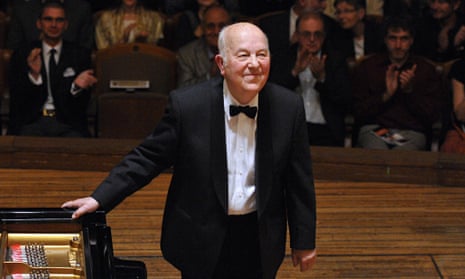The Czech pianist Ivan Moravec, who has died at the age of 84, was one of the finest Chopin interpreters of his age. He took part in masterclasses given by the great Italian pianist Arturo Benedetti Michelangeli in Arezzo in 1957–58 and made his London debut in 1959, but his big breakthrough came with his American recordings, issued by the Connoisseur Society, of 1962. Two years later he appeared in New York with George Szell and the Cleveland Orchestra, though his disagreements with the famously irascible conductor over the choice of piano and the interpretation of Beethoven’s Fourth Concerto meant that he did not appear again in New York for another four years.
Moravec was very much a player of the old school: eschewing the virtuoso warhorses, he had a calm, unruffled, almost phlegmatic posture at the keyboard, in part a matter of natural predisposition and in part the result of a youthful ice-skating injury that forced him to stop playing at the age of 18 when the symptoms recurred. They subsequently disappeared again, but as he himself noted: “Perhaps if I had been completely healthy, with muscles like a bull, my style would be absolutely different.” As it was, he developed a style of unaffected simplicity and a warm, rich sonority based on iridescent tone and precisely calibrated weighting, with generous pedalling: “Whenever I can combine sound to achieve tremendously long sonorities, I do it,” he said. His concern for tonal quality led him to carry a black leather satchel containing tools to remedy unbalanced keys or hammers.
That style was heard to optimum effect in the music of Chopin, for which he was deservedly celebrated, though it also stood him in good stead in French repertoire – Debussy, Ravel and Franck; he additionally played Mozart, Beethoven, Schumann and Brahms, as well as music by his compatriots Smetana, Dvořák and Janáček. In 1969 he was made a professor at the Prague Academy of Music and subsequently gave masterclasses in Italy, as well as concerts in Europe, the US, Japan and elsewhere.
Born in Prague, he was introduced early to music by his father, who was a lawyer, but also an amateur musician and opera-lover. He took piano lessons from the age of seven and made his formal debut in a recital broadcast on the radio in 1946. After studies with Ilona Štěpánová-Kurzová (1952–53), he was invited by Michelangeli to play for him in Arezzo, but according to Moravec’s own account, the Italian pianist concluded: “This young man doesn’t need lessons – he needs only to play.” The short time with Michelangeli was not entirely wasted, however, since the older man also inculcated in him a knowledge of and taste for fine wine.
The brush with Szell did no lasting damage to Moravec’s American career, though he built his reputation as much through recordings (in which he preferred long takes) as through live appearances, even if the PR-driven ethos of the burgeoning recording industry was anathema to him. His 1965 recording of the Chopin Nocturnes, for example (reissued by Elektra Nonesuch in 1991), has not a trace of self-advertisement; on the contrary, from the very first phrases one is drawn into both the sound-world and the emotional territory of the composer. Ripples of filigree decoration are evocative of a moonlit summer night rather than virtuoso display. Not that Moravec’s playing was devoid of fantasy, or even occasionally touches of idiosyncrasy, but he had the ability to register the nuances effected by modulations with the subtlest of hesitations or tonal colouring. The hint of melancholy beneath the placid surface was ever-present.
He brought similar qualities to other repertoire, too. The two-volume set in the Philips Great Pianists of the 20th Century series (1999) demonstrates that introspection and play of colours in both books of Debussy’s Images, in the same composer’s Pour le Piano and in Ravel’s Sonatine, while Franck’s Prelude, Chorale and Fugue is invested with animated clarity of line and expressive grandeur. For Moravec was certainly capable of high drama, as is displayed too in the climactic moments of Chopin’s Fourth Ballade, also in the Great Pianists set.
His performance of Mozart’s Piano Concerto No 22 in E flat, K482, is featured on the soundtrack of the 1984 film adaptation of Peter Shaffer’s play Amadeus. In 2000 his native country awarded him the Charles IV prize for achievement in science, literature or the arts.
Moravec’s first wife, Karla, died in 1960. He is survived by their daughter, Iva, his second wife, Zuzanna, and his stepson, Daniel.
Ivan Moravec, pianist, born 9 November 1930; died 27 July 2015
- This article was amended on 14 June 2017 to include the names of Ivan Moravec’s first wife, his daughter and his stepson

Comments (…)
Sign in or create your Guardian account to join the discussion